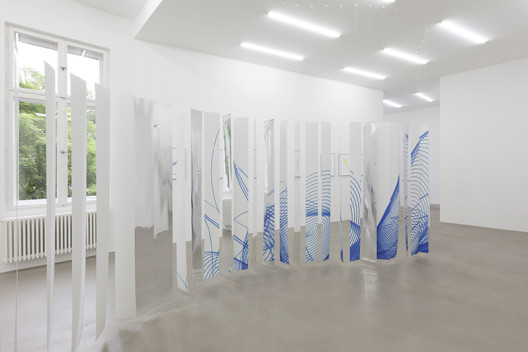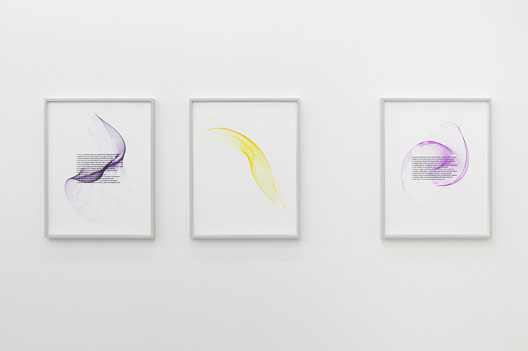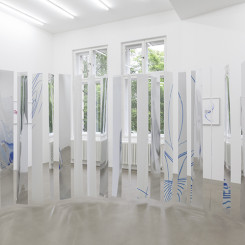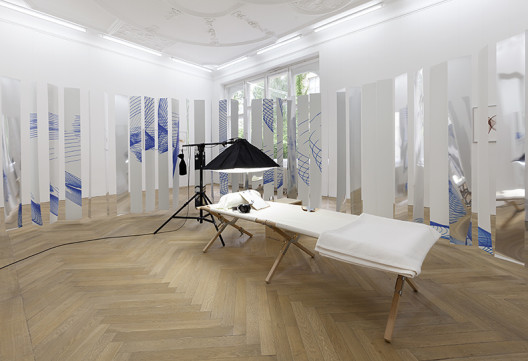“Grey Magic“: solo exhibition by Christoph Keller
Esther Schipper (Schoneberger Ufer 65 D-10785, Berlin, Germany), Jun 29–Sept 5, 2015
Christoph Keller’s current exhibition “Grey Magic” at Esther Schipper oscillates between scientific experiment, historical investigation and phenomenological sculpture, drawing on the paraphysics and esotericism of pre-WW1 Berlin. The exhibition is an attempt to examine the Kantian concept of ‘eccentric sensation’ through the lens of the philosopher and judge Ernst Moses Marcus (1856-1928), and Keller tackles his subject via an ambitious dualistic approach that combines both experimental and historical elements, bound together by a catalogue containing both primary and secondary material. Marcus’ theory hypothesizes that objects are not perceived retinally by a subject; instead, the subject’s eye sends an optical impulse to the brain, causing waves to emanate to the ether. As Keller’s accompanying text notes, “the visual object that is perceived within the brain is then materialized in the form of an ether emanation that is precisely the direction of the optical impulse. Accordingly, what we perceive is an ether world—which is nonetheless real”.
In the piece “Mirror Magic Curtain” (2015), a serpentine of mirrored and printed polystyrene, occupying much of the gallery space, Keller attempts to visualize this highly complex concept and communicate it to the visitor. The spiral reflects the space and the viewer, and as its panels twist and turn in the gallery’s air currents, the viewer sees herself reflected from ever-shifting angles and dizzying multiple perspectives, thus calling the division between ‘real’ space and optical space into question. Keller’s intention is to delocalize the self, to render it present throughout the gallery through the reflections from multiple panels in the spiral. The effects and the division of physical space in the gallery calls to mind the phenomenological aspects of Minimal Art.
The companion piece, “Grey Magic” comprises of a series of wall panels with text, and derives its name from a novel by Salomo Friedlaender/Mynona, “Graue Magie, ein Berliner Nachtschlüsselroman” (Grey Magic, a Berliner Night-key Novel). Mynona’s obscure book is a homage to Marcus’ theses, and indeed, Marcus features as the character Sucram. The book originated from a forgotten segment of avant-garde Berlin literary and artistic society, active around 1906 and 1918, in which Marcus was an active participant, along with such figures as Hannah Höch and Alfred Kubin, and their ideas and thoughts on paraphysics, physiology, psychology and ethereal and rational magic. The panel texts are Keller’s mechanistic, staccato summaries of each chapter. The elements of the exhibition are thus drawn together as an on-going Gesamtkunstwerk, intended to highlight both the scientific and historical genesis of the forgotten theory. Key to it all is the aforementioned catalogue, published by the artist, containing Marcus’s essay, correspondence between Mynona and Marcus, Mynona’s writings, as well as a text that Keller commissioned an academic, Detlef Thiel, to write. This text was subsequently published in an academic journal, furthering Keller’s conceptualist device of blending his art with life. It is difficult, if not impossible to access the exhibition and to comprehend the connection between the works without this text.
Despite this grandiose orchestration of Marcus’ complex and – from contemporary perspectives – hopelessly eccentric interpretation of optical theory, it is not the artwork that lies at the heart of the exhibition, but the perceiving subject, the visitor, who must submit herself to the Kellerian experiment. And indeed, the second room holds the aforementioned white camp-bed and questionnaire about perception: the visitor is invited to fill out a Ganzfeld test about her notions of paranormal phenomena such as ESP and dream prediction, then must lie still for ten minutes under a bright photographic light, ears covered by headphones emitting white noise, eyes covered by red goggles, and then reproduce any ‘visions’ seen on paper. When the exhibition concludes, the questionnaires will be collated for comparison.
While Keller’s attempt to explore ‘eccentric sensation’ through historical, scientific and narrative means fascinates, however, it fails to cohere owing to an over-reliance on an extensive theoretical background which cannot be fully resolved by the elements of the exhibition itself. The exhibition feels constrained by its physical limitations: if there were more space and more time for Keller to present his investigation, this would allow for a fuller exploration of Marcus’ indubitably interesting hypotheses. We can thus hope that in the future, Keller will be afforded the institutional setting that this work deserves.

Christoph Keller, “Magic Mirror Curtain”, mirrored and digitally printed polystyrene panels, thread, 200 x 20 x 0.1 cm each, 125 panels, 200 x 2500 x 0.1 cm overall, 2015. Courtesy by The Artist and Esther Schipper, Berlin. Photo: © Andrea Rossetti.

Christoph Keller, “Grey Magic – Spirals (Chapter 7, Dark Purple Spiral)”, archival inkjet print on Hahnemühle paper, 58.8 x 46.2 x 3 cm (framed), 2015; “Grey Magic – Spirals (Yellow Spiral)”, archival inkjet print on Hahnemühle paper, 58.8 x 46.2 x 3 cm (framed), 2015; “Grey Magic – Spirals (Chapter 8, Magenta Spiral)”, archival inkjet print on Hahnemühle paper, 58.8 x 46.2 x 3 cm (framed), 2015. Courtesy by The Artist and Esther Schipper, Berlin. Photo: © Andrea Rossetti.

